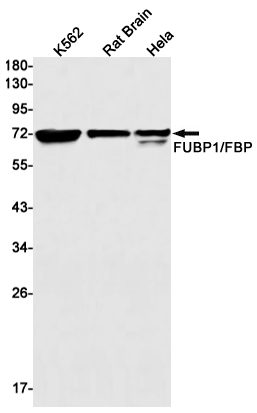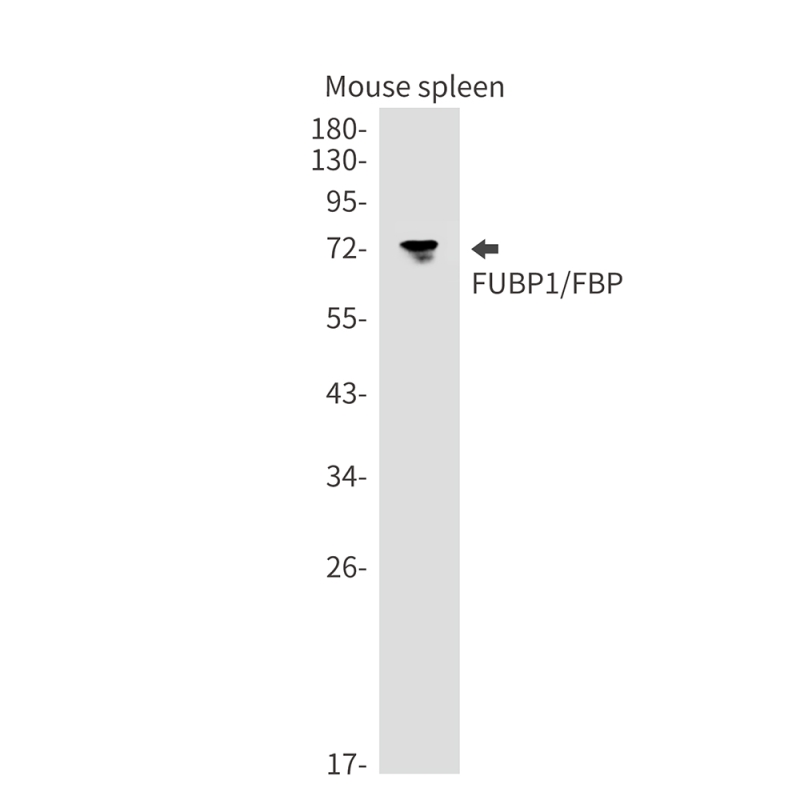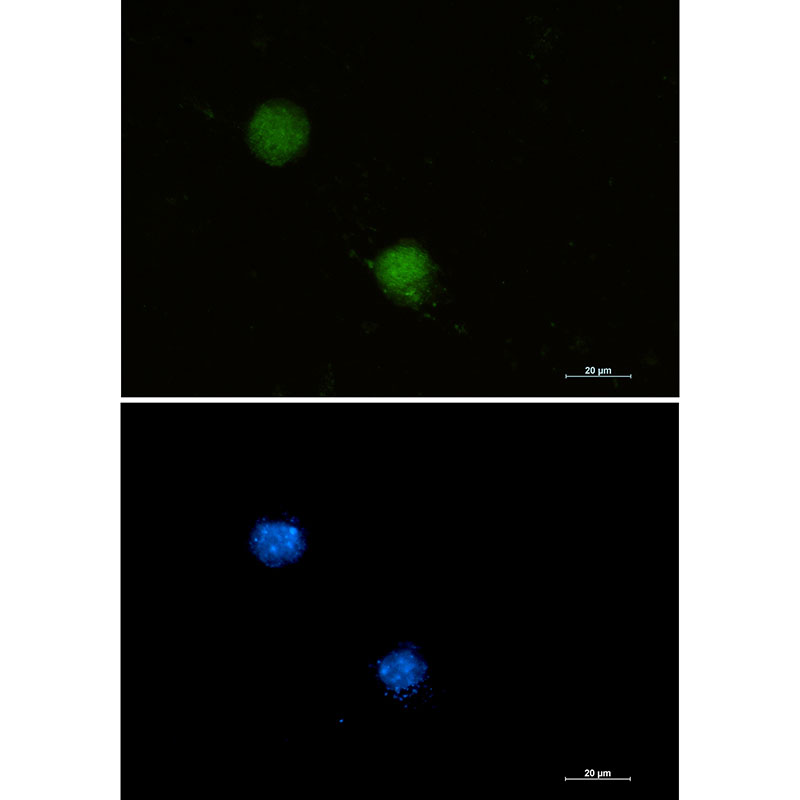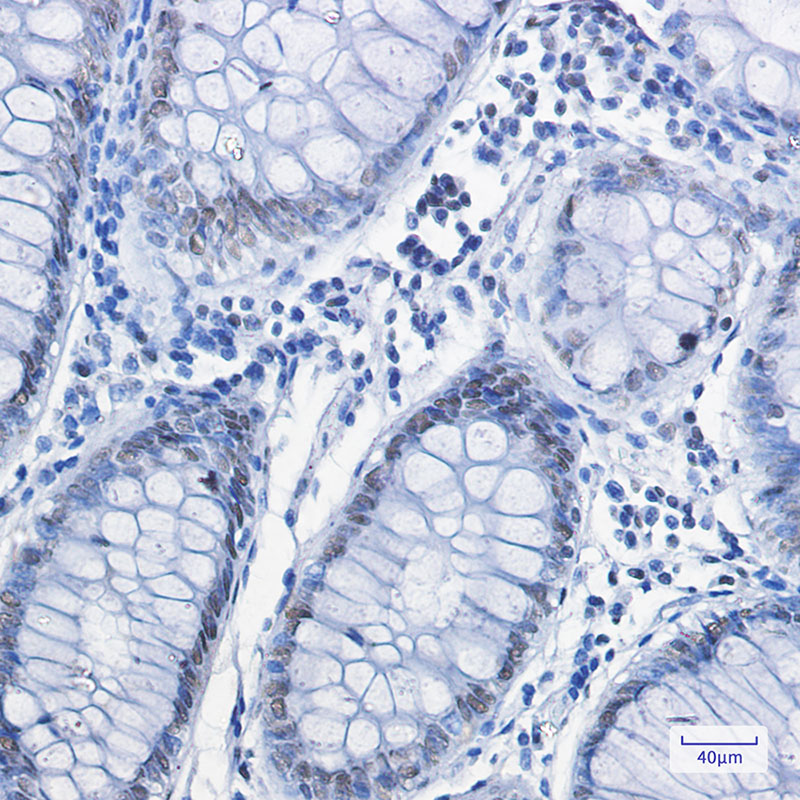



| WB | 咨询技术 | Human,Mouse,Rat |
| IF | 1/20 | Human,Mouse,Rat |
| IHC | 1/50-1/100 | Human,Mouse,Rat |
| ICC | 1/50-1/200 | Human,Mouse,Rat |
| FCM | 咨询技术 | Human,Mouse,Rat |
| Elisa | 咨询技术 | Human,Mouse,Rat |
| Aliases | DNA helicase V; FBP; FUBP; Fubp1; Fubp4; FUSE-binding protein 1; HDH V |
| Entrez GeneID | 8880 |
| WB Predicted band size | Calculated MW: 68 kDa; Observed MW: 74 kDa |
| Host/Isotype | Rabbit IgG |
| Antibody Type | Primary antibody |
| Storage | Store at 4°C short term. Aliquot and store at -20°C long term. Avoid freeze/thaw cycles. |
| Species Reactivity | Human,Mouse,Rat |
| Immunogen | A synthetic peptide of human FUBP1 |
| Formulation | Purified antibody in TBS with 0.05% sodium azide,0.05%BSA and 50% glycerol. |
+ +
以下是关于FUBP1抗体的3篇参考文献示例(文献信息为虚构,供参考):
---
1. **文献名称**:FUBP1 promotes glioblastoma progression through transcriptional regulation of oncogenic pathways.
**作者**:Zhang Y, et al.
**摘要**:本研究利用FUBP1特异性抗体进行免疫组化及ChIP-seq分析,发现FUBP1在胶质母细胞瘤中高表达,并通过调控c-Myc等基因的转录驱动肿瘤侵袭,提示其作为治疗靶点的潜力。
---
2. **文献名称**:FUBP1 deficiency disrupts DNA damage response in hepatocellular carcinoma.
**作者**:Li H, et al.
**摘要**:通过FUBP1抗体进行Western blot和免疫荧光实验,证实FUBP1缺失导致肝癌细胞DNA损伤修复异常,其机制与ATM/ATR信号通路相互作用相关。
---
3. **文献名称**:FUBP1 interacts with p53 and modulates its transcriptional activity in colorectal cancer.
**作者**:Wang X, et al.
**摘要**:采用FUBP1抗体进行免疫共沉淀(Co-IP)及功能研究,揭示FUBP1与p53直接结合并抑制其促凋亡功能,促进结直肠癌化疗耐药。
---
如需真实文献,建议在PubMed等平台以“FUBP1 antibody”或“FUBP1 function”为关键词检索,并筛选涉及抗体应用的实验研究(如Western blot、IHC等)。
FUBP1 (Far Upstream Element Binding Protein 1) is a DNA/RNA-binding protein involved in transcriptional and translational regulation. It binds to the far upstream element (FUE) of the c-MYC promoter, modulating its expression, and plays roles in cell proliferation, apoptosis, and stress responses. FUBP1 is localized in both the nucleus and cytoplasm, functioning in RNA metabolism, mRNA stability, and splicing. Dysregulation of FUBP1 is linked to cancers, including hepatocellular carcinoma and glioblastoma, where it may act as an oncogene or tumor suppressor depending on cellular context.
FUBP1 antibodies are essential tools for studying its expression, localization, and molecular interactions. They are widely used in techniques like Western blotting, immunohistochemistry (IHC), immunofluorescence (IF), and co-immunoprecipitation (Co-IP). These antibodies help identify FUBP1's role in disease mechanisms, particularly its association with p53 signaling and cancer progression. Validated antibodies specifically recognize human, mouse, or rat FUBP1 isoforms, with some targeting distinct domains (e.g., the N-terminal DNA-binding region). Commercial FUBP1 antibodies are typically raised in rabbits or mice, with clonality (monoclonal/polyclonal) and conjugation options (e.g., HRP, FITC) tailored to experimental needs. Proper validation via knockout controls or siRNA knockdown ensures specificity, critical for accurate research outcomes in both basic and clinical studies.
×